The Parents of Sarah Rebecca Mary MURRAY
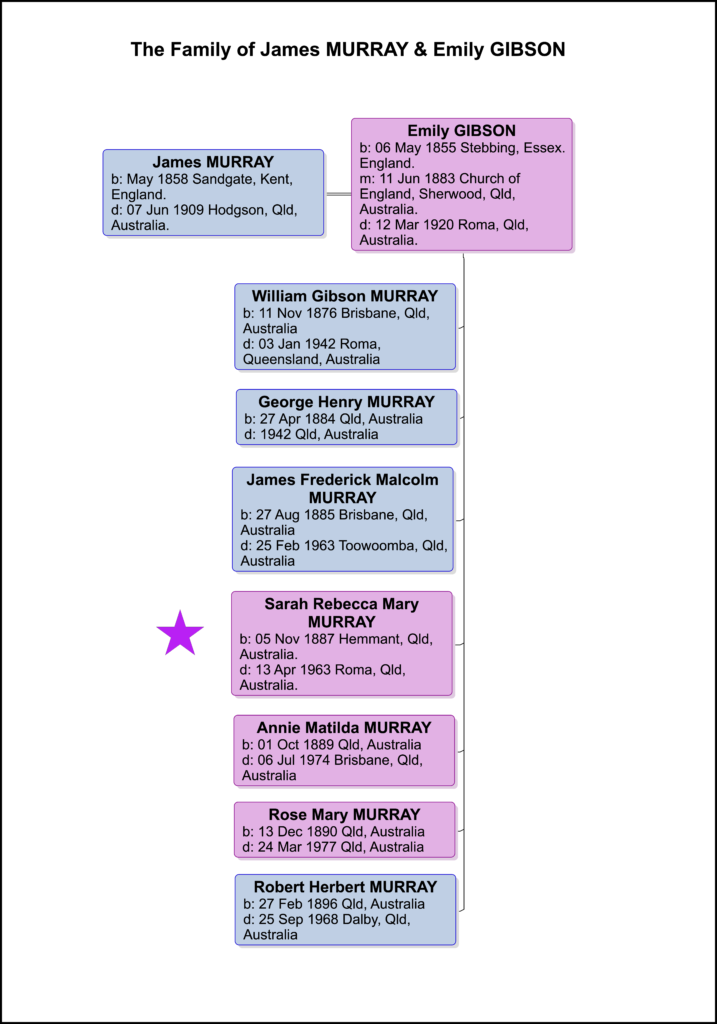
James MURRAY
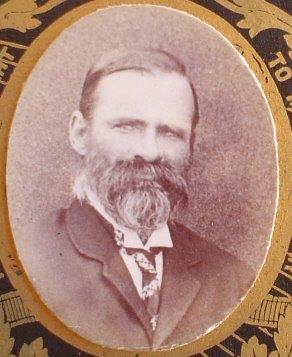
1909.
James Murray was a twin in the first set of several sets of twins born to William Malcolm Orr Murray and Sarah Scott. He (and his sister Sarah) were born on 16 April 1858 at 8.30pm at Cheriton near Sandgate in Kent, England.

16 April, 1858.
At the time of James’ & Sarah’s birth, their father William was a Corporal with the North Down Militia based at the Shorncliffe Barracks at Cheriton. Previous to this, he had been a handloom weaver in Glasgow. William and Sarah’s story can be found here.
Within three years the family were back in Glasgow and William had again taken up cotton weaving.1 The family was living at 396 Great Eastern Road. But by 1863, the family had decided to migrate to Australia.
Immigration
It would have been quite an experience for a young boy of five years to travel from Glasgow to Ireland and then to board a ship at Queenstown (now Cobh) and sail for nearly three and half months to reach Moreton Bay in Queensland. For more on the voyage of the ‘Golden Dream’ please his parent’s story.
Australia
After arriving in Moreton Bay, the family moved to the Coopers Plains area. James would have spent much of his childhood in the Coopers Plains area south of Brisbane. Being the oldest boy in the family, James would have had some schooling but also helping his father with any jobs that could be found. He had many younger sisters and brothers – eight in all – to help with.
The family moved to the Beaudesert/Canungra area in the late 1870’s as his father was working on ‘Telemon Station‘ and his older sister Annie Jane was married here in 1880.
Emily GIBSON
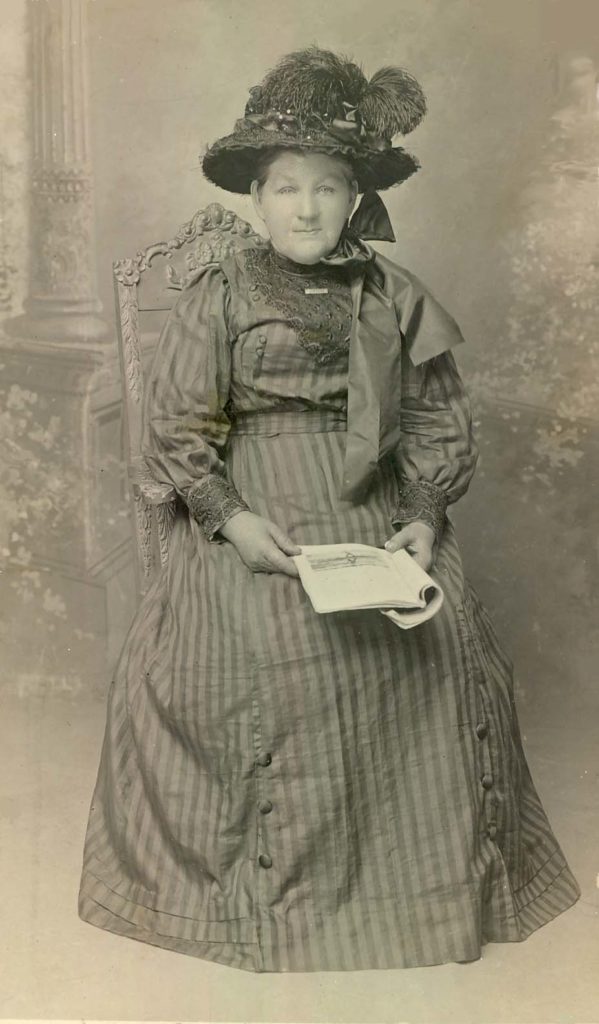
Emily was the oldest child of ten children born to Henry GIBSON and Rebecca Sharp in Stebbing, Essex. She was born on the 5 May, 1855.2 Please note on the Birth record below that the mother’s name is Sharpe, so we know this is our Emily.
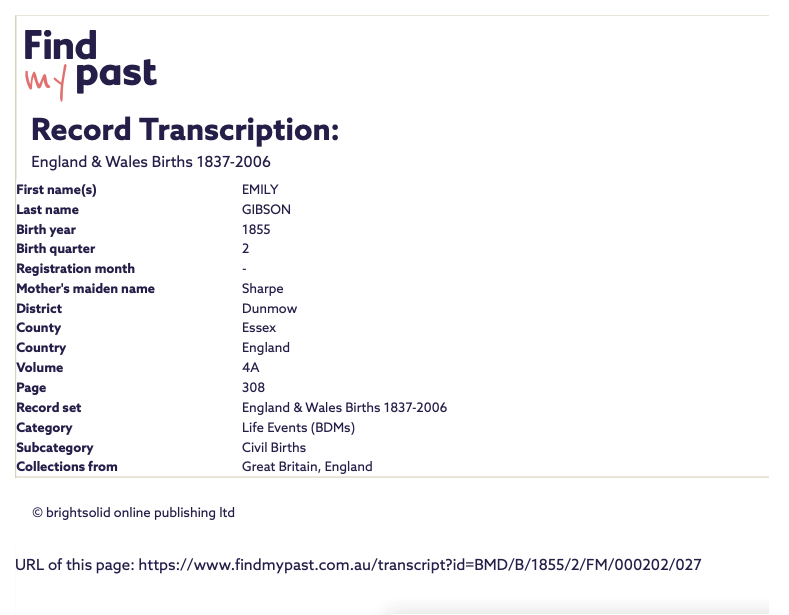
April-June, 1855.
NOTE: On some ancestry.com trees, people have Emily with the middle name of Clara. In all the official records I have found, I have never found Emily with a second name, let alone Clara. Perhaps they got the Clara from Emily Clara Gibson, born 1856 in Battersea, Surrey to father; Henry, but mother; Ann Elizabeth. On other trees, people have Emily being baptised in 1855 at St Nicolas at Fyfield, Essex. However, even though that Sarah’s father was Henry, her mother was Sarah. Also this Emily was in the England census of 1881 and 1891 even though our Emily was living in Australia by then. Also, in the family, Emily has six sisters and only one has a second name.
Emily would have spent much of her childhood in Stebbing where her father was a labourer. But by 1871 she was working as a domestic servant for Joseph and Annie Downing at High Street, Braintree. Joseph was a chemist, druggist and wine and spirit merchant. He and Anne had four children aged between two and six years. So probably, Emily was also helping with the family as she had had six younger siblings by 1871 and, I’m sure, would have helped her mother looking after them. Braintree was about 8 kilometres from Stebbing.
Immigration
However, in 1874, Emily joined the rest of the family and travelled to Australia on the ‘Zoroaster. It would have been a different voyage for Emily as opposed to James. Emily was 18 years old and the eldest child of the family. With the youngest three children being five, three and one years of age, Emily, no doubt, helped her mother with looking after them and also washing clothes etc. More of the voyage can be found in her parent’s story.
Australia
I feel life would not have been easy for Emily during her first few years in Australia. Upon arriving in Moreton Bay in September, 1874, she would have helped the family set up home and look after her younger siblings. Her youngest brother Harry Charles, one year old, died just over a month after arriving. Her mother, Rebecca, was pregnant again in 1875 and gave birth to her last child, Louisa in October. However, both her mother and the child died by 1876 leaving her father Henry with seven children aged from Emily (21 years) to Rose (5 years). The Gibson family settled in the Yeerongpilly/Coopers Plains area.
On 11 November 1876, Emily gave birth to a son William Gibson. She would have fallen pregnant only several months after arriving in Australia. There is no record of the father as the son carries the name ‘Gibson’ as his surname in the Birth records. James Murray would have been 18 years old and did not marry Emily for another seven years, therefore I don’t believe James is the father.
Marriage
James and Emily were married by James Samuel Hassell, Church of England clergyman of Sherwood on 11 June, 1883. James was 25 years old, and a ‘labourer’ living at Coopers Plains. Emily was 28 years old. The witnesses at the wedding were John William Murray and Mary Adams. Mary Adams was James’ younger sister who had married William Adams the previous year. I’m not sure who John William Murray is – perhaps a cousin.
Family
It seems James and Emily stayed in the Brisbane Area until at least 1889. During this time, they had their family – George Henry (1884), James Frederick Malcolm (1885), Sarah Rebecca Mary (1887) at Hemmant, Annie Matilda (1889) at Oxley, Rose Mary (1890) and Robert Herbert (1896).
Hodgson & Land
James applied for Government land in the Roma Land Court in September 1891. James had 80 acres conditionally approved at Hodgson (Portion 62V) for lease on 5 September, 1891.3 It was in the Hodgson village settlement and the rental was sixpence per acre per annum and after the payment of five year’s rent (that is half-a-crown an acre), these properties became freehold. Amongst the conditions was one had to have a personal residence on the property. So, in 1896, holders of these selections were given notice of their intention to apply for Certificates of Fulfillment of Conditions on their farms, to be held at the Roma Land Court. James was included in this and he was registered as the lessee of Portion 62V at Hodgson.
Mention is made by Lorna Murray, James and Emily’s grand-daughter (George Henry, father), in her story.
Their house was built of rough slabs and a bark roof and dirt floor. Originally the kitchen was a lean-to outside. Emily cooked in pots hung on hooks over a wood fire. They lived north of the creek at Hodgson and water was carted from the creek for household use.
Emily was a good manager in the house and taught her daughters to cook, sew and crochet. through necessity as one can well imagine in those days, there were few sewing machines or any of the mod cons we have today.
James also applied for leasehold of Portion 14V at Bindango, west of Hodgson on 13 August, 1904. This land of 160 acres was next door to son George Henry’s block 15V and a couple away from future son-in-law, George Alfred Johnson.
Gleanings from The Western Star & Roma Advertiser
Possibly all the children except for William Gibson, would have attended the Hodgson Provisional (later State) School which had opened on 1 February, 1876.
There was a notice from the Police Court that a James Murray was arraigned for Stealing a pair of barber’s scissors, and was sent to jail for fourteen days in July, 1897. Not sure if this is our James.
In July, 1901, James tendered to the Bungil Divisional Board to erect a footbridge at Hodgson for £15, over two months. He was successful in his application.4 James also tendered to construct a crossing over the Chinchinbilla Creek in August of the same year for £27.10s over a period of eight weeks. However, he’s was not successful in that tender.5
James was also community minded and was on the Hodgson State School committee during 1906.6 and Emily give a donation of a pair of white leghorn fowls to be raffled with the proceeds going to the Roma Hospital appeal at the Hodgson dance in May 1907.7
In late October 1907, there was mention of the wheat crop at Hodgson. The areas under crop were smaller than usual, which was due to the luxuriant growth of weeds preventing ploughing operations being conducted very extensively. There had been a long stretch of dry weather and most farmers were surprised at the returns they were getting. With wheat at 5 shillings (50 cents) and more a bushel (about 27 kilos), a half-crop in that year was equal to a full crop in an ordinary season. the best crop was being harvested by Mr J.G. Brumpton who was averaging 5 bags to the acre. Mention is made of Henry, Fred and George Johnson. James Murray had cut some of his crop for hay, but was expecting to get 150 bags from his remaining 60 acres. Mr W. Murray was expected to ge 30 bags f rom40 acres.8
In 1908, James and Emily were living on the property ‘Sunnybank‘ at Hodgson according to the Electoral Roll.
In May,1909, James received a notice from the District Land Office. He was called to appear at the Land Commissioner’s Court to be held in Roma on 9 July to show cause why his Agricultural Homestead no. 1839, Roma District, being portion 14v, containing 160 acres, should not be declared forfeited for non-fulfilment of the condition of occupation. Eight others were also notified for the same appearance.9
Death
Sadly, one month later, James Murray died of suffocating from drowning in Cains Lagoon, Hodgson on 7 June, 1909.
A small notice appeared in the Western Star & Roma Advertiser on 16 June, 1909:
Mrs. James Murray and Family, of Hodgson, beg to THANK their many friends for their kindness and sympathy in their recent sad bereavement.
There were a number of articles in the Western Star & Roma Advertiser in June, 1909 about the death of James and the Magisterial Inquiry into his death. The articles are as follows:
Hodgson Drowning of James Murray
Saturday 12 June 1909, page 2.
On Tuesday the Roma police were informed that a man named James Murray, about 50 years of age, residing at Hodgson, was missing. A constable and a tracker left for Hodgson on Tuesday night, where they discovered the body of the missing man in a lagoon about a quarter of a mile from the town on Thursday afternoon. An inquiry is to be held.
Saturday 19 June 1909, page 2.
At the Roma Police Court on Thursday, an inquiry, concerning the death of James Murray, Hodgson on the 7th inst., was heard before Mr. W. Harris, P.M. Sergt. Doherty conducted the inquiry.
William John Plummer, licensed victualler at Hodgson, deposed that on Monday, the 7th inst., deceased was at his hotel during the afternoon, and had three drinks of whisky. About 6.30 p.m. he left, and went in the direction of the town. Before leaving he purchased half a pint of whisky, which he took away with him. He did not appear to be under the influence of liquor. He was alone when he left the hotel, and was very cheerful.
About 10 o’clock on the following morning deceased’s son Robert, who is about 12 years of age, came to the hotel and asked if his father was there, and witness told him he had gone home the night before. On Thursday, 10 inst., in consequence of something he had heard, witness went to a lagoon known as”Cain’s Lagoon”, and situated about half a mile from the hotel. Deceased used to take a short cut through the paddock on his way home after leaving the hotel.
When he arrived at the lagoon he saw Constable Sullivan and others dragging in it. He returned to the lagoon the next day, and there saw the dead body of the deceased in a shed about 150 yards from the lagoon. When deceased was at the hotel in the 7th inst., he had a quarrel with a man named Alice Shirrel, a selector on Dargal Creek.
Witness was not there at the commencement of the quarrel, but when he arrived Shirrel had his coat off, and was drunk and excited. He heard deceased say, “if you hit me, I’ll hit you.” Shirrel replied, “I won’t hit you Murray, but I’ll throw you over my head.” Witness got Shirrel to put on his coat, and got the two men to shake hands. He then got his brother, James Plummer, to take Shirrel away to his (witness) father’s place. This took place at about 5.50 p.m.John Edward Pratt, Government medical officer, deposed that he held a post-mortem examination of the deceased, and he attributed the cause of death to suffocation by drowning.
George Henry Murray, son of deceased, said that on the 9th inst. he went with Constable Sullivan and started to drag the lagoon. At about 5 p.m. on the following day they recovered the body of a man which he identified as his father. His father was 51 years of age, and was on good terms with his neighbours.
Michael Sullivan, police constable stationed at Roma, deposed that he found deceased in the centre of the lagoon. he saw no signs of a struggle having taken place, and saw no marks of violence on the body.
The inquiry was then adjourned.
Wednesday 23 June 1909.
Further evidence was taken in the inquiry into the death of James Murray at Hodgson, by drowning on the 7th inst. The inquiry closed after hearing the evidence of Benjamin Rayner, Kate Shirrel, and James Plummer.
As mentioned in the above newspaper articles, George Henry Murray, James’ son, identified the body. George was 25 years old at the time. He wrote a statement which was included in the Body of Evidence for the Inquiry. Some of the official papers and his handwritten statement can be read here. I have included a transcript of his statement as it is hard to interpret.
A point of interest from the inquiry: William John Plummer, the licensed victualler (hotel owner), married Louisa Emily Johnson in 1894. Louisa was the older sister of George Alfred (Alf) Johnson, who married James daughter Sarah Rebecca Mary.
James Murray was buried in the Hodgson cemetery on 11 June, 1909, in the ‘Presbyterian section in a fully paid for public grave at a depth of 6 feet (yes, they even recorded how deep they were buried in the Hodgson cemetery register).
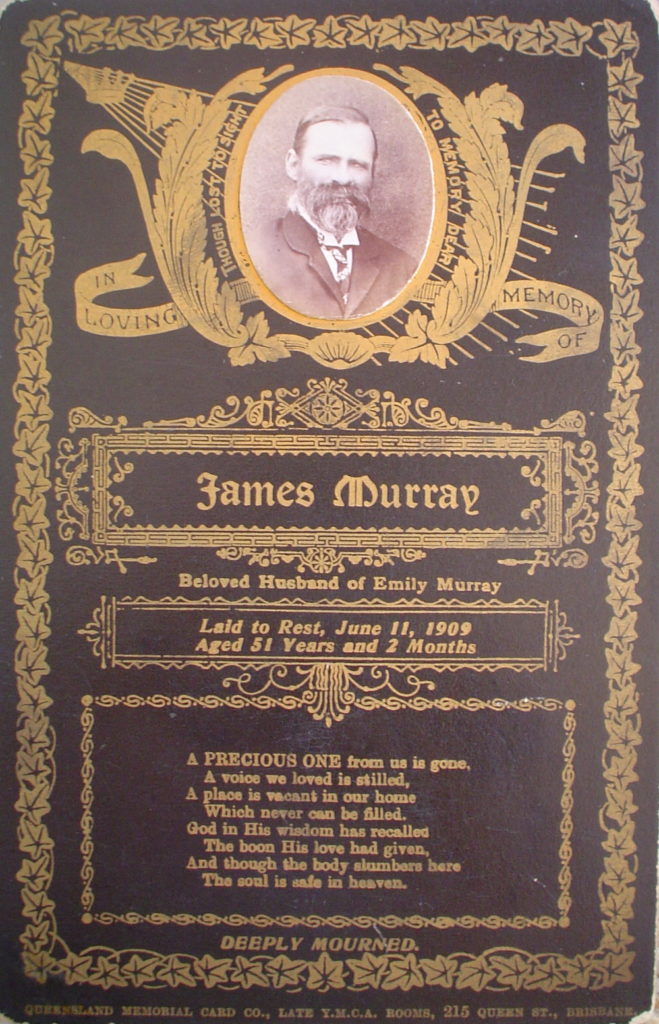
Courtesy of Lorna Murray.
In
Loving Memory
of
JAMES MURRAY
Beloved Husband of
Emily Murray
Laid to rest June 11 1900
Aged 51 years
“Thy will be done“
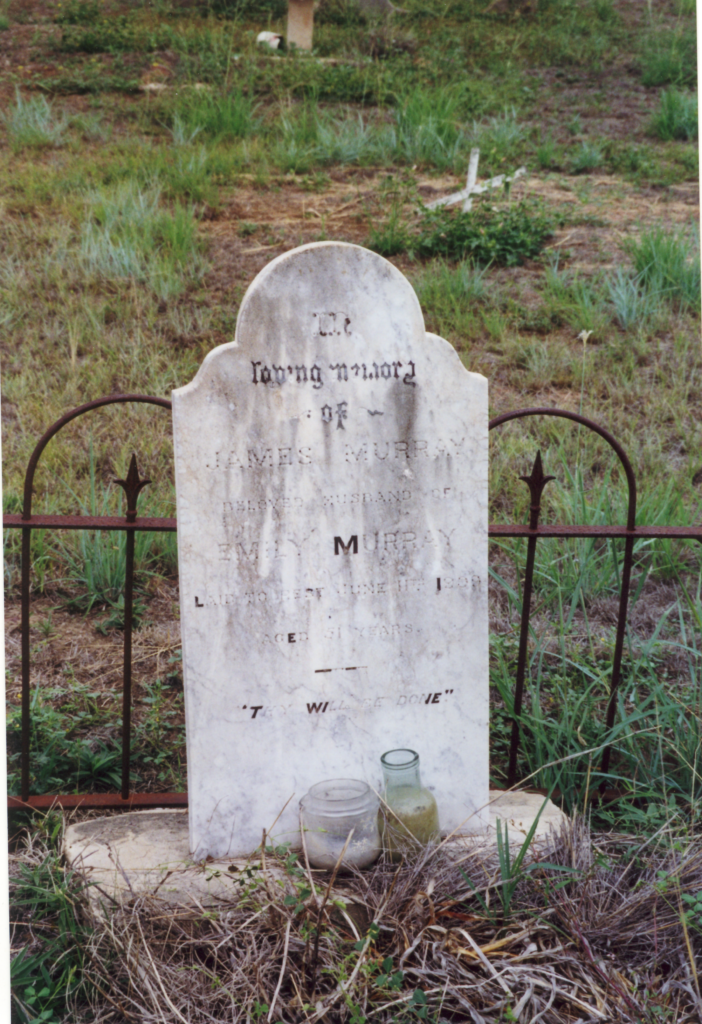
Hodgson Cemetery.
One can only try to imagine how Emily was feeling after James’ drowning. It would have brought back memories of her paternal grandfather Joseph Gibson, and his suicide by drowning back in Stebbing Essex, when she was about five or six years old. And not only had she to contend with the James’ death and all the paperwork that involved, but Emily also had the forfeiture of their land hanging over her head. Luckily, Emily only had two children living with her at the time, Rose aged 19 years and Robert aged 13 years. All the rest of the children were married except for George Henry but he would have been living on his own block of land, which was situated next to one of James and Emily’s blocks.
The case for the forfeiture of the block of land, Portion 14v, was heard in late July/early August. It was mentioned in the Western Star & Roma Advertiser that ‘the forfeiture was waived provided a residence was carried out in a bonafide manner for two years in most of the cases heard but, three years for James Murray’. efn_note]Western Star & Roma Advertiser. Wednesday 11 August 1909, page 3. trove.nla.gov.au.[/efn_note]
Statutory Notice to Creditors10 were issued in July and Letters of Administration of £25011 were issued in December.
In June 1910, approximately one year after James died, Emily had the application for the 160 acres of land, Portion 14v, accepted.12 This block was west of Hodgson on the Ten Chain Road (now Donnybrook Road), and next to the block of her son George Henry, and two blocks away from daughter Sarah Johnson, wife of Alf. Obviously, Emily had help in establishing a residence on this property to fill the conditions, not only from her two older sons and sons-in-law but from several of James’ brothers and the wider community.
INSERT MAP FROM BRUCE JOHNSON
MENTION OF EMILY PURCHASING PORTION 14V ON 9.9.1913 IN LAND RECORDS after visit to State Archives..
Emily wrote a letter to her daughter, Sara (Sarah), on month before she died. It was written from her youngest daughter Rose’s home in Morven, where Emily was staying. The first page is continued on the side of that page and numbered 11 and then continues onto the second page. Also there are not many full stops and sentences run into each other. Obviously the message written sideways at the top of the first page was an add on just before sending the letter. An interpretation of the letter can be found here.
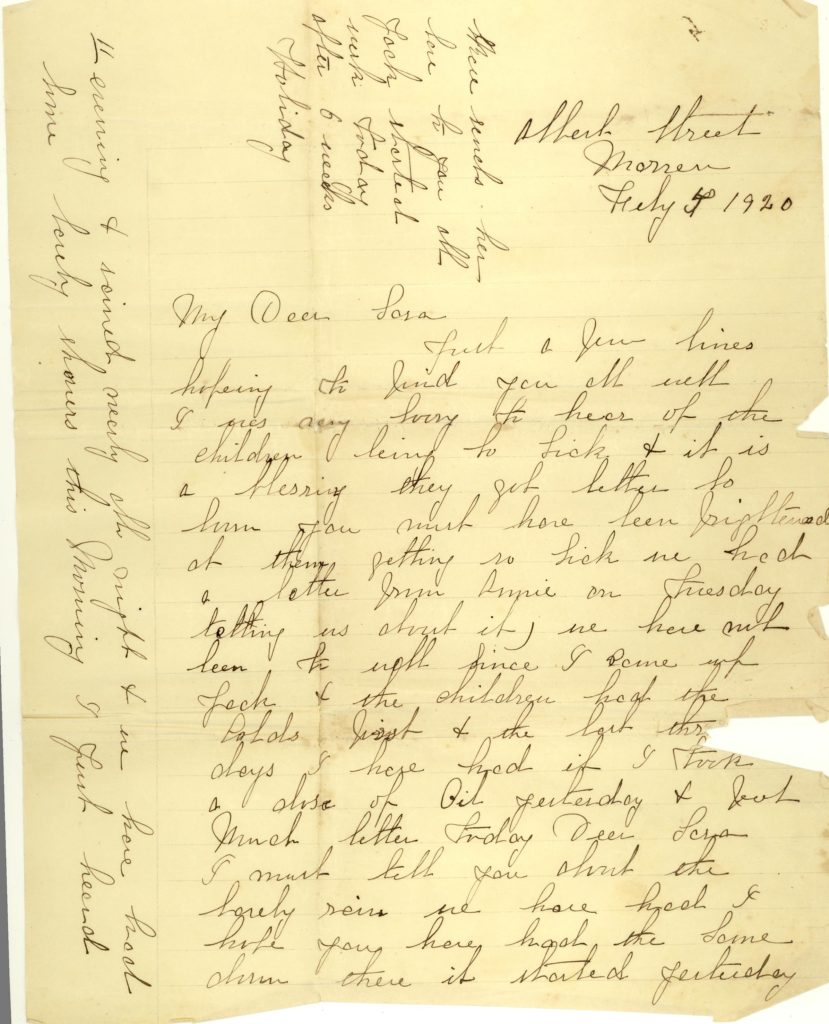
from her mother Emily Gibson
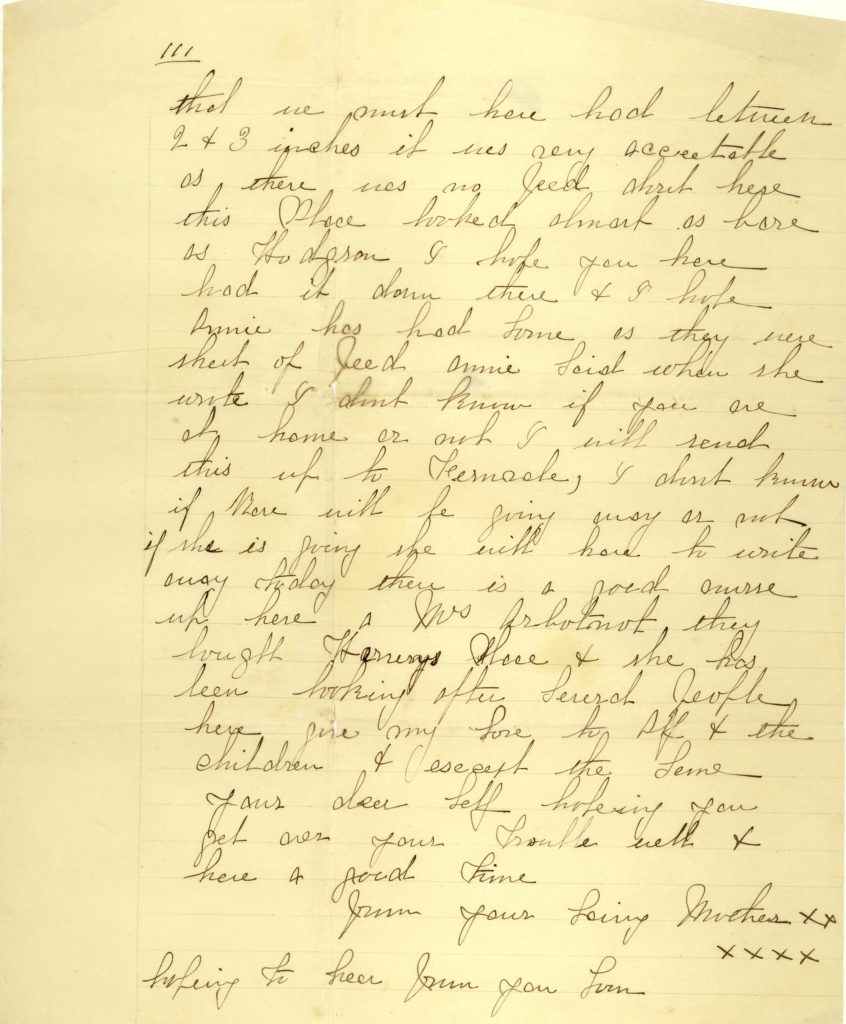
from her mother Emily Gibson
It was interesting in the letter that Emily, after catching the colds the children had, took a dose of oil and felt much better. I remember my mother giving me a dose of caster oil with orange juice (to dull the taste – it didn’t) whenever I got sick or had a cold in my younger days. You always had to be really sick to stay at home from school as you knew you would be getting a dose and it tasted foul. Obviously a remedy handed down from daughter to daughter.
When Emily wrote this letter, Sara would have been very pregnant with Sybil (my mother, born 10 days later on 17 February) and the boys would have been approximately: Len(10), Ron (8), Aub (6), Merv (4) and Wadj (2).
Emily survived James by 11 years and died at the Roma Hospital on 12 March, 1920, aged 65 years. She died of senility apoplexy syncope, which as far as I can determine, was low blood pressure resulting in an effusion of blood on the brain because of her age, thereby causing her to fall into unconsciousness. The senility is not a decrease in mental abilities but just a description of the apoplexy.
Emily was buried in the Hodgson cemetery next to James in the Presbyterian section and again at 6 feet in a fully paid for public grave.
Sacred to
The Memory of
Our Loving Mother
EMILY MURRAY
Died 11th March 1920
“Sleep on Beloved“
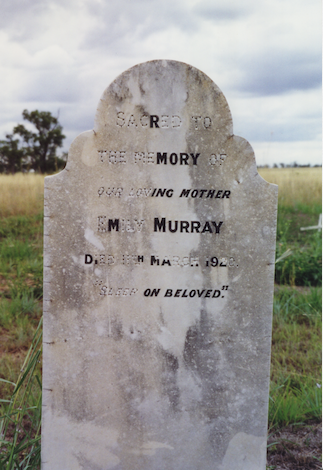
Hodgson Cemetery.
The two blocks of land that Emily owned were advertised in the Western Star & Roma Advertiser during August, 1921 and mention of the sales were listed in the Wednesday 24 August edition of that Paper:
Sale of Hodgson Properties – On Friday at Roma, Mr. T. A. Spencer offered two properties at Hodgson for sale by public auction in the estate of the late Emily and James Murray. There was keen competition for the area of 80 acres (portion 62v) which was eventually purchased by Mrs. Woodcroft for £301. This price is equivalent to about £4 per acre for the freehold, and is largely in excess of values hitherto accepted for similar land in the district. Another area of 160 acres (portion 16v) at Dargal Creek, near Hodgson, was sold to Mr. Cormack for £162.
Children
As mentioned above, William Gibson ‘Billy’ was born on 11 November, 1876, seven years before his mother Emily married James Murray. His mother had not long arrived in Brisbane when she fell pregnant. William took the Murray name after his mother’s marriage to James Murray.
William married Sarah Mary Whell on 17 March, 1902 in Roma.13 Sarah was the daughter of John Whell and Bridget Ryan. 14
William was a farmer on Dargal Creek near Hodgson in 1903, and selected 160 acres (64.75 hectares) in the Bungeworgorai parish in 1905. He and Sarah continued living and farming here until after 1925. By 1930, they were living at “Llandreath“, a block he had selected at Amby, near Charleville. Willie and Sarah did not have any children that I know of.
William died on 3 January, 1942.15 His obituary in the Friday, 20 February, 1942 Western Star & Roma Advertiser edition read:
‘It is with regret I have to report the death of Mr. W. G. Murray, which occurred at Roma Hospital on the 3rd January, the result of a car accident whilst travelling from Roma to Landwreath (writes a correspondent). Mr. Murray was 65 years of age, and was on of the first settlers on Dargal Creek, and selected land there in 1900. He carried on the occupation of arming and dairying, and later acquired the property, Landwreath, on Amby Downs resumption, which he used for cattle and sheep raising. Billy, as he was familiarly known, will be greatly missed, as his qualifications and good fellowship as a neighbour and his cheerful disposition were unequalled. He leaves a wife, three sisters and three brothers to mourn their loss.’
Sarah lived for another 22 years retiring to a house in Roma. She suffered a sight disability and I’m not sure if she had it all her life or it came on in later life. However, I remember my mother, Sybil Maiden (nee Johnson – Billy’s niece)mentioning that ‘Aunty Sarah always kept a clean house: could sweep the floors; cook her own meals; and even had a garden. She had stick posts with string strung between on either side of her footpath to lead to the front gate.
Sarah died on 14 January 1964 and is buried beside William in the Roma Cemetery.
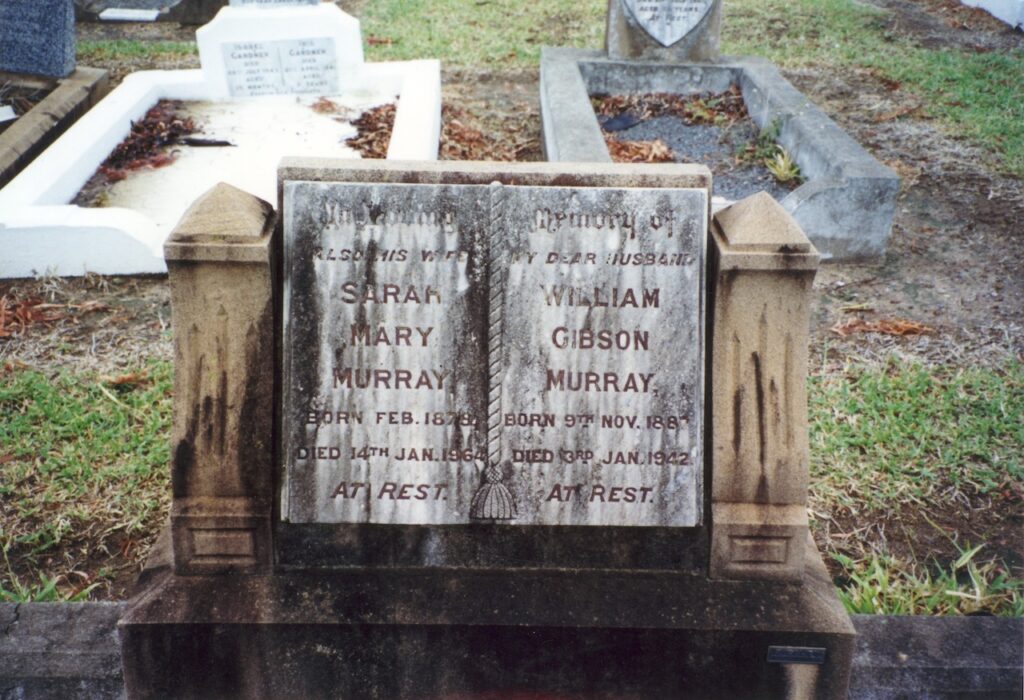
Roma Cemetery.
There is a mistake on the date of William Gibson Murray’s gravestone. It has him being born in 1887, whereas his birth certificate shows that he was born in 1876.
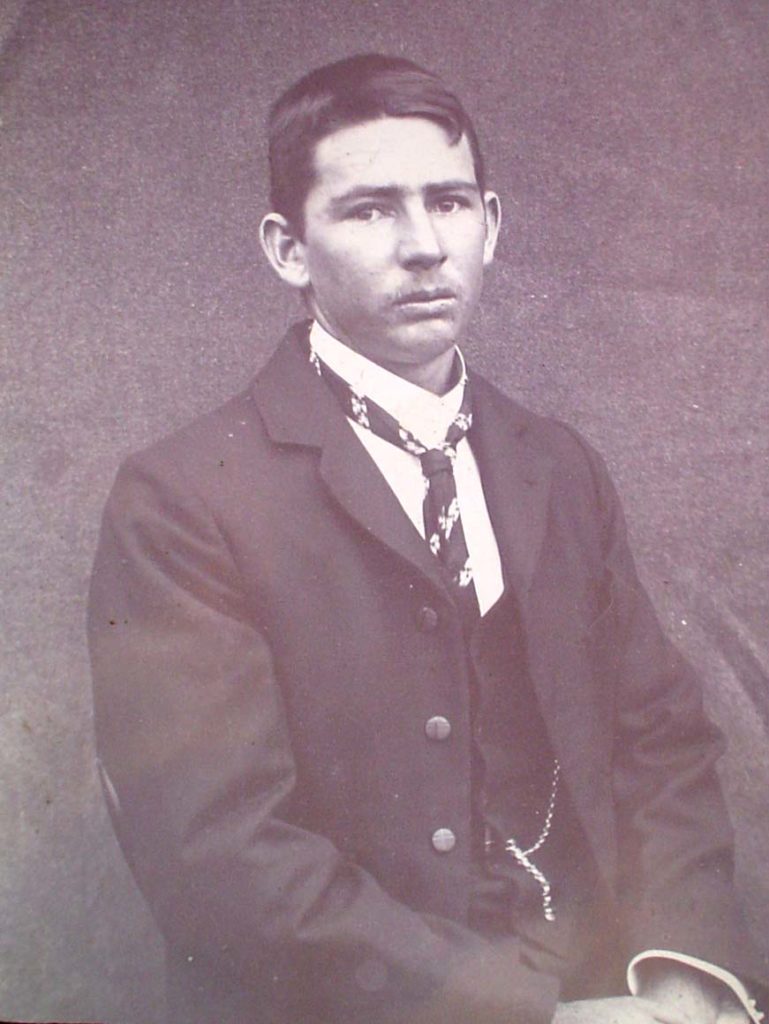
Courtesy: Lorna Murray.
George Henry, the second son, was born on 27 April, 1884 and grew up at Hodgson. At the age of 25 years, he was with the local constable when they found his father James’ body in Cains Lagoon as a result of drowning. George also gave evidence at the inquest into his father’s death. (See above in his parents story).
George applied and was granted a lease of 160 acres at Bindango in 1904 and purchased it in 1908.
He married Charlotte Agnes Stinson (nee Stewart) on 20 August, 1912. Charlotte was born at Cattle Creek, near Roma on 18 September, 1879. Her parents were William Stewart and Catherine Flood.
Charlotte ad previously married Alexander Stinson in 1898 and they had three children, Eliza (1899), John William (1902) and Isabel (1905). Alex died in 1909.
Lorna Murray, George Henry and Charlotte’s daughter, wrote a short story about the family. I have added dates in { }.
Charlotte was formerly married to Alexander Stinson {1898}. They first lived in a one room hut at Joe Moore’s bore on ‘Mt. Abundance Station‘. Charlotte cooked outside in a lean-to. They had three children, Eliza, William and Isabel. They later took up land at Hodgson, Portion 58V and 59V. It was called ‘Rosebank‘. Alex died with encephalitis or meningitis {1909}.
When she married George Murray {1912} they continued to live at ‘Rosebank‘. He had a block of land to the north of Clerk’s Creek which was referred as the ‘top selection’. They also had another out the Dargal which was called the Dargal paddock.
George was returning home on horseback when attacked and badly stung by a swarm of bees. He was in a coma for some time and never fully recovered. His health gradually deteriorated and Charlotte was left on the farm to rear the family. They had two children, Jessie Amelia who married J. T. Taylor and Lorna Agnes who married N. J. Murray. Charlotte and children ran a dairy and took the cream to Hodgson Railway to be sent to the Roma Butter Factory.
The neighbours were good to Charlotte and most kept an eye on things for her and at times helped. She also employed some help at times. She rode ‘side saddle’. She had a slide made from a forked tree with a tank on it and ‘Old Dick’ the draught horse pulled it down to the lagoon to be filled by bucket and taken back home.
When gas was discovered in Roma, she decided to sell out and she went into Roma. Purchased a house in Charles Street, previously owned by a Mrs. Forrester, who had a shop in McDowall Street. Mr Forrester was a member of the Roma Town Council. Charlotte remained living in the same house until she passed away {1964}.
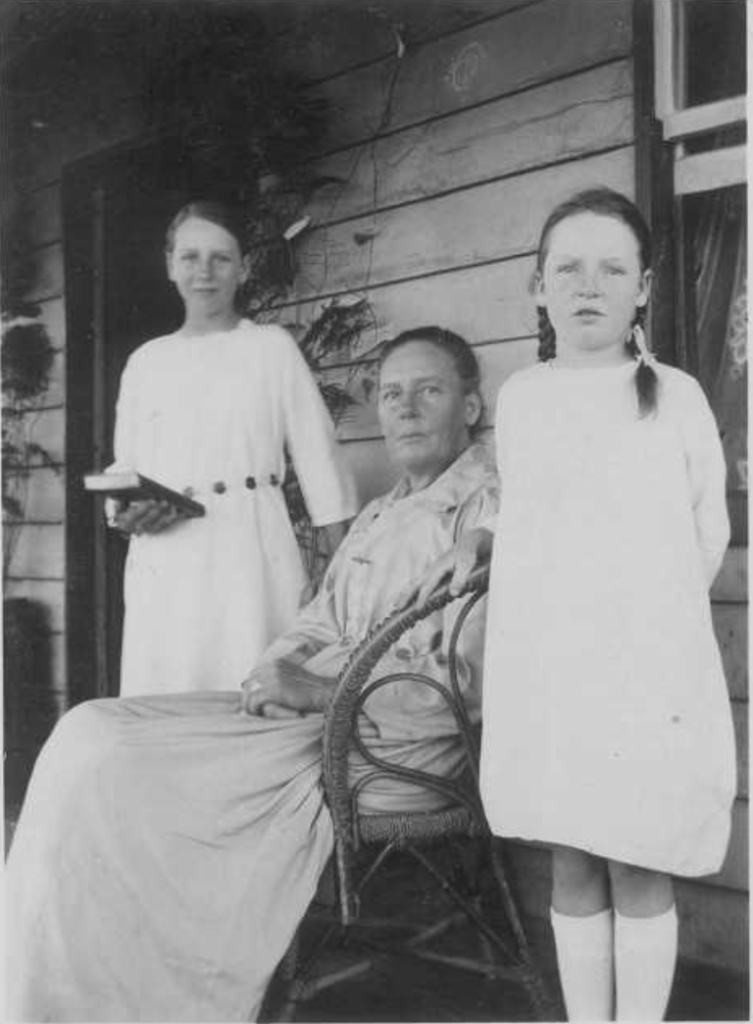
C. 1927.
60 Charles Street, Roma.
courtesy of Des Taylor.
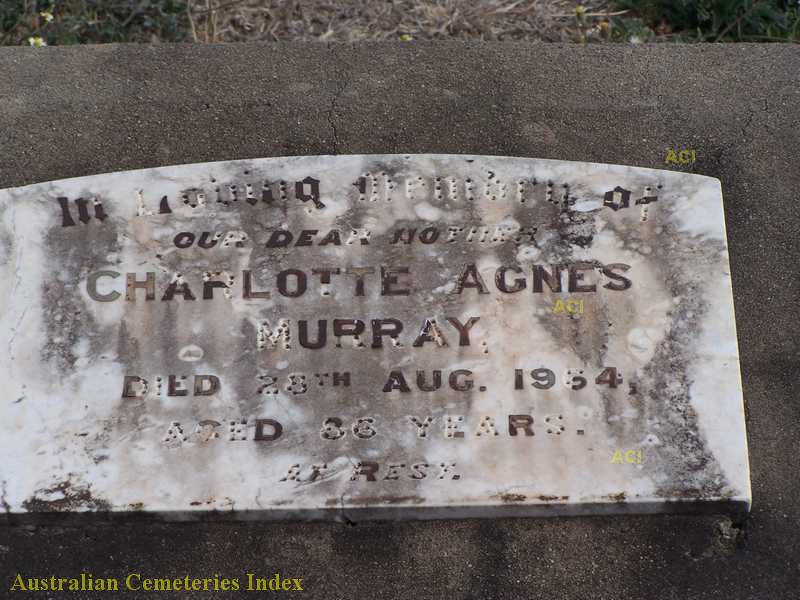
Roma Cemetery.
Australia Cemetery Index.
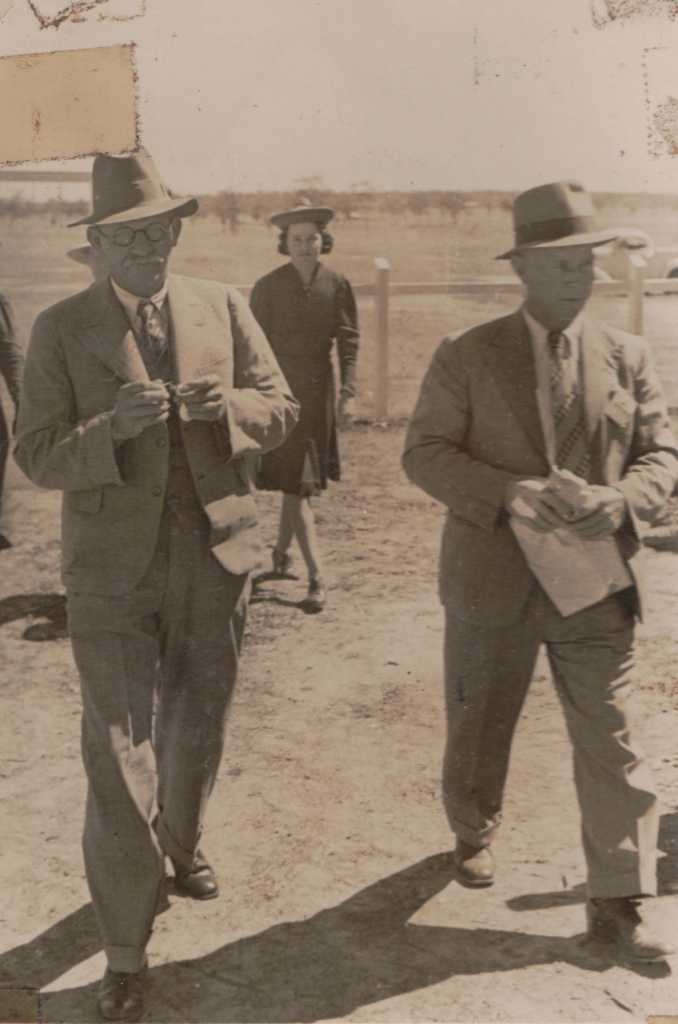
with Vida MURRAY in background
at Roma Show.
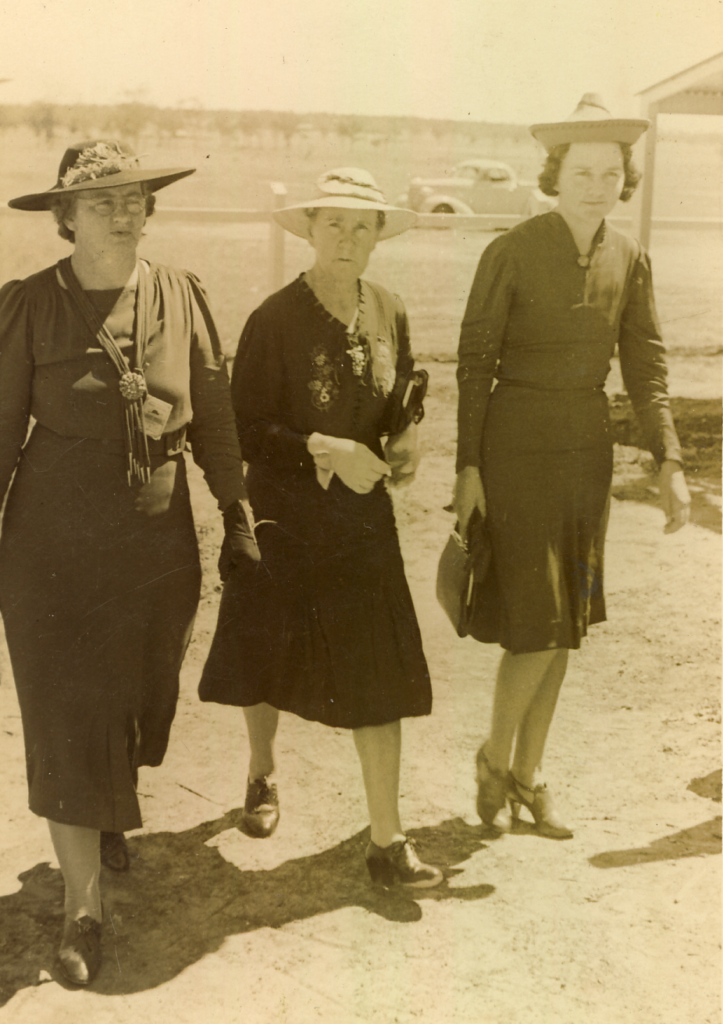
at Roma Show.
James Frederick Malcolm, the third son, was born on 27 August, 1885 in Brisbane. James did labouring around the Hodgson area in his early life.
He married Elizabeth May Teague in 14 October, 1908. Elizabeth, known as May, was the daughter of Joseph William Teague and Florence Sutton. She was born in 1882 in Brisbane and moved with there parents to Wallumbilla in about 1890. William Teague applied for several block of land at Wallumbilla in 1891 and 1897. The property was called ‘Bethel‘. William was also the local Wesleyan preacher at Wallumbilla.
James and May acquired ‘Wilga Park‘ at Hodgson, possibly before 1919. It can be confusing as to when he got ‘Wilga Park‘ as according to the Western Star & Roma Advertiser, there is a ‘Wilga Park‘ at Hodgson, Mitchell, on the Durham Downs Road (owned by A M Hunt) and at St. George. However, in the Western Star & Roma Advertiser in August 1919, there is a Memoriam notice for May’s brother John, who died at the Somme,in France, from M and J Murray of ‘Wilga Park‘, Hodgson.
James also became a Bungil Shire Councillor during the 1920-30’s16. May and James lived at ‘Wilga Park‘ until the late 1940’s when they retired to Toowoomba, living at 22 Herries Street, and then 24 Underwood Crescent17.
They had four children: Malcolm Frederick (1909), Daisy Emily (1911), Colin Teague (1912) and Vida May (1920). There is a photo of May with her parents and the three oldest children, possibly taken at Wallumbilla.
James died on 25 February 1963 and May died on 13 March 1976. They are buried at the Drayton and Toowoomba Cemetery.
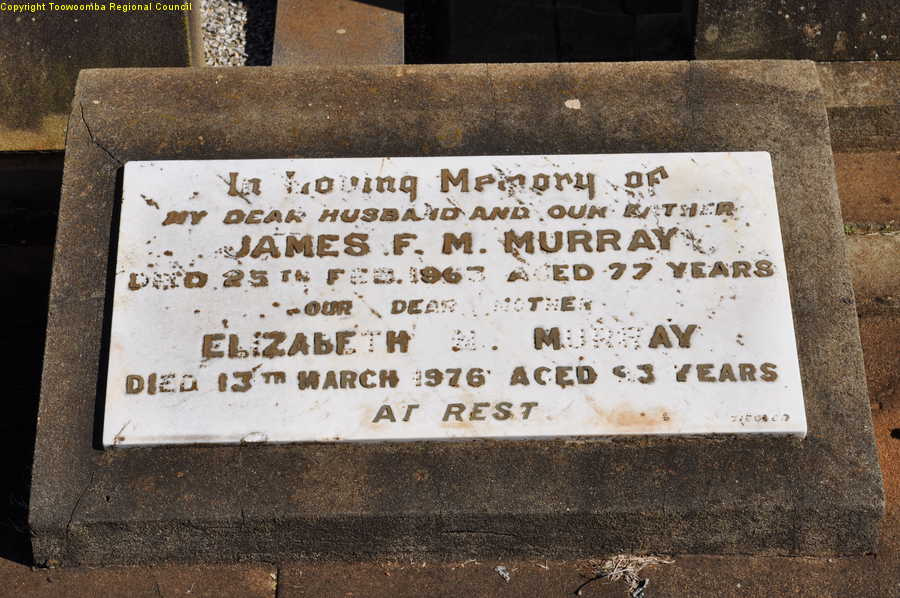
Drayton and Toowoomba Cemetery.
Sarah Rebecca Mary Murray (my grandmother) and Alf Johnson’s story can be found here.
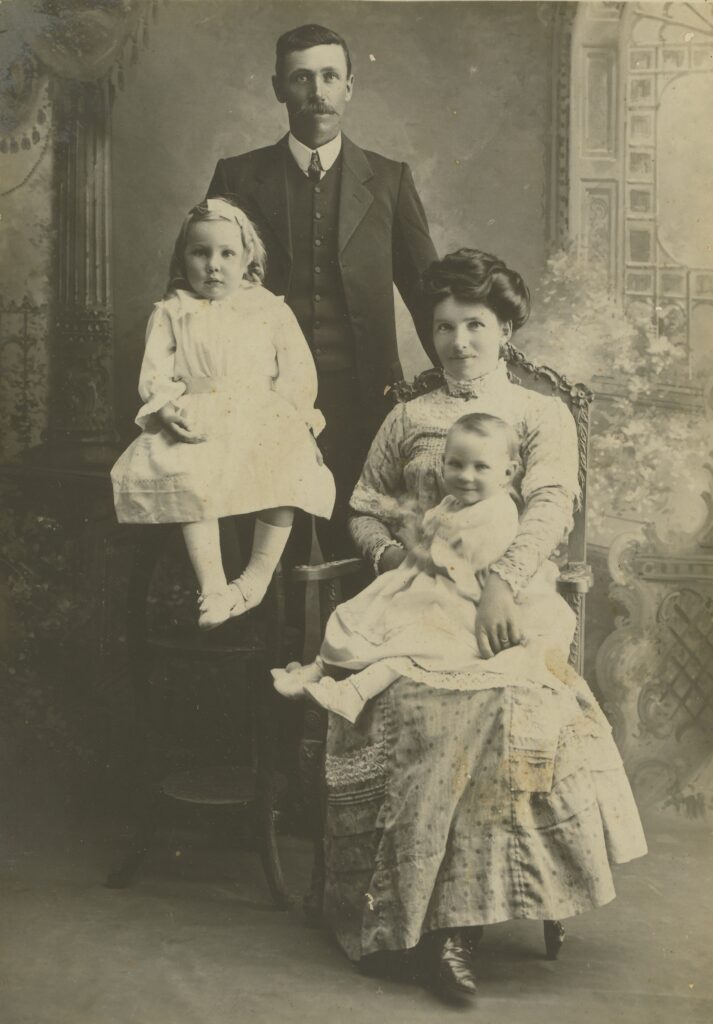
c1912.
Annie Matilda, the fifth child, was born in Oxley, Brisbane on 1 October, 1889. She married Alfred (Alf) Ernest Warner on 27 July, 1908 at Hodgson. One can imagine there would always be a little bit of confusion as Annie and her older sister, Sarah, both had husbands named Alf. As Annie was under the age of 21 years, she had to have consent of her father to marry.
Alfred, who was the son of Frederic George Warner and Matilde Rosalie Emilie Ahrens, was born in Roma on 29 December, 1880. He grew up in the Hodgson area and his father owned the property ‘Glyndhurst‘, which was freehold. His father died in 1899, and Alfred took over the running of the property. They had seven children over thirteen years, Laura Adeline bertha, Esther Emily, Alfred Laurence, Annie May, Margaret Mary, Jean Ashby and Allan Frederick.
Ree Warner, a descendant of Annie and Alf, has written a short story and memories of their life.
During their early years of marriage and starting their family, they lived on their property “Glyndhurst’ , Hodgson. while still raising their family, they moved to another property in which Alf had drawn 2 blocks by ballot, ‘Allandale’ being the main homestead block and ‘Beefwood‘ being the other. (It may have actually been subdivided when he later sold ‘Beefwood’ to his youngest son Allan). On ‘Allandale’, Alf firstly built the woodshed, then the house himself. He was not a carpenter, although considering he faired well (lasted for three generations) but the enormous kitchen floor ended up warping so much there was always a massive hill in the middle. These properties were situated 15 miles north of Muckadilla. In the early days they had to ride or go there by sulky just to collect three mail. The children also had to go some distance to school by sulky.
I can remember my father telling of an unfortunate large family that lived nearby, whose mother had died during childbirth. The father had a very hard time trying to manage the farm and take proper care of his children and they often went to school without breakfast or school lunches. So all of the school mothers would pack extra lunches for the Lee children and often send home meals with the children. These children had it harder than most and it was feared that they may not make adulthood. However, they have all grown up to lead healthy prosperous lives.
When Alf drew the ‘Allandale‘ block, he was building and living in the woodshed. Nanny remained at ‘Glyndhurst ‘with the 7 children. Many swaggies used to walk from farm to farm, working fr a meal, accommodation or food. A man came to the door on day with a knife and demanded food. nana held herself well, demanding he chopped wood first before she gave him food like everyone else had to. She then gave him all of their food. Fortunately the man left. Nanny packed the sulky and the children and fled to ‘Allandale‘. Upon arriving she found Grand asleep in the wool shed and hand’t progressed much with the building at all. He tried to send her back to Hodgson, but she was terrified to go back. They then all lived in a bower shed until the house was built. I always thought Alf had built it from scratch but Mum said, “He put it together & finished it off but it was moved from somewhere, Ipswich, unsure”.
Nana worked hard having seven children, but of course they all helped out. Dad told me stories of how she would bring water up from the dam, fill bottles with it and jam them upside down into the ground to slowly water her garden. Apparently she grew an amazing amount of fruit and veggies, some being apricots, figs, peaches, pumpkins and watermelons. the main washing was done with a wash board at the dam, but the Sunday whites and best were washed in rainwater. Annie was quite good at crochet, most of us receiving at least a rug and covered coat hanger. Also she would buy good quality linen handkerchiefs with man made lace, in which she would cut off the lace and re-crocheted the edges.
‘The Warner Family’ – courtesy Maree Warner. underthepandanustree on ancestry.com
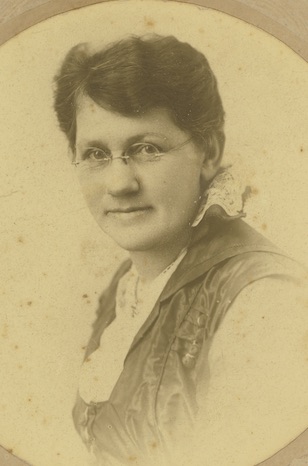
Alf and Annie lived at the property ‘Allandale’ until about the early 1950’s and then retired to 4 Crawford Street, Roma. They lived there for several years but by 1968, they had moved to 43 Moore Street, Morningside in Brisbane. They then shifted to the Carina Nursing Home.18
I recall visiting Grand Dad at Carina Nursing Home, Creek, R.d, Carina. Until this point they lived in their own home just behind Aunty Meg’s house at Morningside, Brisbane. As a child I recall walking with Aunty Meg and Cindy the neighbourhood dog, to visit them at their house. Nanny would make tea and cakes. Grand Dad would come up from potting about in his vegetable garden or be reading the papers. He only ever watched the 6pm new on their TV.
On visiting him in the nursing home, he was seated in front of the TV all day completely separate from Nanny for the first time in years. He was given hard boiled lollies which he was unable to chew and steaks that he had the same problem with. His mind went very quickly, out of sheer boredom and loneliness. Nanny came from another wing to visit as often as possible. He would be terribly upset as in his mind it took her four days to walk across the great desert in the heat of the day with no water. His health and mind declined very rapidly. Had he been at home this may have happened also as they weren’t taking as good care of themselves.
Nanny, on the other hand, was busy crocheting for everyone in the nursing home and family also.
‘The Warner Family’ – courtesy Maree Warner. underthepandanustree on ancestry.com
Alf died on 7 July, 1971 and Annie died three years less one day later, on 6 July 1974.
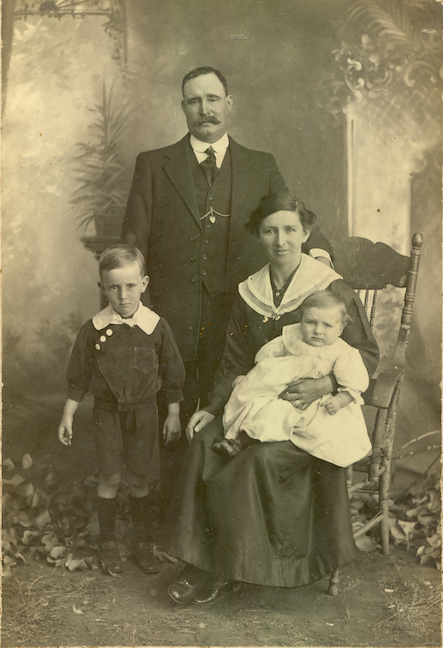
John and Roy. c1918.
Rose Mary, born 13 December, 1890, was the youngest girl and second last child of James and Emily Murray. She grew up in the Hodgson area.
Rose married John (Jack) Byrnes on 12 December, 1912. Jack was the son of Henry John and Mary Byrnes. John had been a labourer at Bendena Bore near ‘Clifton Station‘ in the early 1900’s. After marrying Rose, the family lived at Morven from, at least, 1913 to 1919.19
Rose and Jack had three children, John (1913-1988), Henry (1915-1917) and Roy (1917-1977). By 1925, the family had moved to Beenleigh where John was a fettler with the railways. They lived there at Grey Street, for many years.
Jack died on 16 June 1959, and Rose on 24 March 1977. They are buried at the Lutwyche Cemetery in Brisbane.
Most of the information I have for Rose & Jack has been gathered from the Electoral rolls. It would be great to contact a descendant of the Byrnes family.
If you have any more information,
Could you please contact me so I can add to this story.
Robert Herbert Murray or ‘Uncle Bob’, as he was fondly known by the younger generation, was the last child of James and Emily. He was born on 27 February, 1896, probably at Hodgson. Bob would have attended the Hodgson State School and grown up around the Hodgson area.
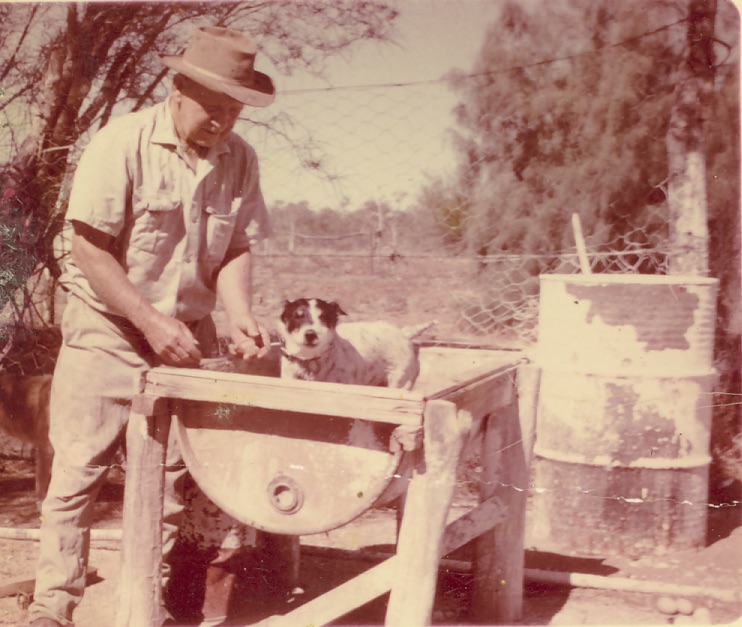
Uncle Bob was a confirmed bachelor and heavy smoker, and, he even admitted in his early days a heavy drinker. He was a great worker and could turn his hand to anything needed on a property either sheep or cattle or to do with cultivating, fencing etc. His constant companion in his later years was his dog, Paddy – a fox terrier.
Bob worked at properties as far as Muttaburra ( ‘Brookwood‘) and Barcaldine. He helped out his nephew Geoff Johnson at his properties, both named ‘Waddington‘ at Nipan near Theodore and also at Oakey. Other people and properties over the years were: Lionel Murray (‘Glencoe‘, Bungeworgorai), his sister Sarah and husband Alf Johnson (‘Lanreef‘, Hodgson),20 his other sister Annie and husband Alf Warner (‘Allandale’, Hodgson), my parents Lloyd and Sybil Maiden( ‘Bellevue’, Roma) and many others.
Some memories of Uncle Bob:
I was very young when Uncle Bob worked for my Dad at ‘Bellevue‘, south of Roma. I do remember Mum and Dad mentioning that when Uncle Bob was ploughing the paddocks for cultivation, there would be a Bex powder wrappers around the paddock. [Bex powders were a compound analgesic that comprised aspirin, phenacetin and caffeine. They were addictive and banned in 1977]. Uncle Bob was also a heavy smoker of roll your own cigarettes.
Gillian Walters – Grand niece of Robert Murray.
He would come and help us out occasionally. He used to eat with us, but never slept in the house. He used to bath in the dam in summer and have a wash in the shed in winter. When I think back, that was terribly unfair, but he never expected anything else. He had a caravan and with his terrier Paddy sharing the space, it was on the honk. After meals, he’d crab his hat and call out “Where’s the Lad?”; Paddy would come out from under the house or tank. They were inseparable. He supposedly had a girlfriend at one time, or maybe that was just teasing on behalf of the Johnson boys. She was referred to as Tilly as she was too big to be a car, but not as big as a truck! I don’t know if there was ever anything in it. I think he was the butt of lots of jokes, especially from the boy cousins .
Verne Summers – Grand niece of Robert Murray.
Robert Herbert better known as “Uncle Bob’ was an old batchelor and a smoker of old. His faithful companion was Paddy, the fox terrier dog. he lived and worked around the Muttaburra area for years. He also worked around Barcaldine where he admitted himself that he was a bit of a drunk, after his mates left him in the Local cemetery after an all night binge. When he woke up amidst the tombstones covered icicles he vowed he would never drink again!
As a child, I can remember Uncle Bob visiting my parents property ‘Allan Dale’ near Hodgson. I was a bad asthmatic and Uncle Bob insisted on coming inside the house and puffing his smoke all over me. this gave me instant asthma repeatedly until my mother told him he could only smoke outside. We kids used to go int stitches as we watched Uncle bob having a nap in the shade of the mulberry tree, using Paddy the dog as a pillow while Paddy’s fleas skated around Bob’s bald head.
Courtesy Robyn O’Sullivan – Grand niece of Robert Murray.
Bob was working on a property near Dalby when he fell ill. He died 25 September, 1968 and is buried in the Dalby Cemetery.
If you have any more information,
Could you please contact me so I can add to this story.
- 1861 Scotland Census
- Val Hanlon ‘Gibson Generations’
- Western Star & Roma Advertiser, Saturday 5 September, 1891, page 2. trove.nla.gov.au.
- Western Star & Roma Advertiser, Saturday 6 July, 1901, page 3. trove.nla.gov.au.
- Western Star & Roma Advertiser, Saturday, 10 August 1901, page 3. trove.nla.gov.au.
- Western Star & Roma Advertiser, Wednesday 24 1907, page 2. trove.nla.gov.au
- Western Star & Roma Advertiser, Wednesday 12 May, 1907, page 2. trove.nla.gov.au
- Western Star & Roma Advertiser, Wednesday 30 October 1907, page 2. trove.nla.gov.au
- Western Star & Roma Advertiser, Saturday 1 May 1909,page 3.
- Western Star & Roma Advertiser. Saturday 31 July 9109, page 3. trove.nla.com.au.
- Brisbane Courier. 24 December, 1909, page 10. trove.nla.gov.au
- Western Star & Roma Advertiser. Saturday 11 June 1910, page 3.
- Qld Births, Deaths & Marriages. Reg no. 001516.
- Qld. Births, Deaths and Marriages. Reg. No. 001516
- Australia, Death Index, 1787-1985. ancestry.com. Reg. No: 000704. Page 1688.
- Western Star & Roma Advertiser
- Qld. Electoral Rolls
- Qld. Electoral Rolls
- Qld. Electoral Rolls
- Qld. Electoral Rolls
